 |
|
|
| (Information by Peter Kessler, with additional information by Geoffrey Tobin and Edward Dawson, from Brittany: Many Kingdoms or One?, Jean-Michel Pognat, from Province and Empire: Brittany and the Carolingians, Julia M H Smith, part of The Cambridge Studies in Medieval Life and Thought series (1992), from The Ethnology of Germany Part 3: The Migration of the Saxons, Henry H Howorth (Journal of the Anthropological Institute of Great Britain and Ireland, Vol 7, 1878), from The History of the Franks, Volume II, Gregory of Tours (O M Dalton, Trans, 1967), from The History of Normandy and of England, Francis Palgrave (1864), from English Historical Documents c.500-1042: Chronicle of Nantes (Chapter 27), Dorothy Whitelock (Ed, Second Edition, 1979), and from External Links: The Works of Julius Caesar: Gallic Wars, and PopulationData.net.) |
|
|
| c.799 - ? |
Frodoald |
An Austrasian. First (Frankish) count of Vannes. |
| 818 |
King Louis 'the Pious' (Louis-le-Pieux) of the Frankish empire sends Abbot Witchar to negotiate with King Morvan of Brittany, which fails. Louis assembles an army in the spring of 818 at Vannes, within the 'Breton March' which at this point is controlled by the Franks. 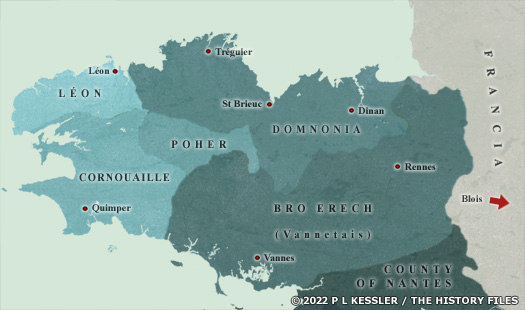 Vannetais was created during the late fourth century AD, enjoying a peak of expansion and power up until 491 (click or tap on map to view full sized) Vannetais was created during the late fourth century AD, enjoying a peak of expansion and power up until 491 (click or tap on map to view full sized) |
|
| King Louis 'the Pious' (Louis-le-Pieux) of the Frankish empire sends Abbot Witchar to negotiate with King Morvan of Brittany, which fails. Louis assembles an army in the spring of 818 at Vannes, within the 'Breton March' which at this point is controlled by the Franks. With Lambert of Nantes in support, he launches a series of attacks against various Breton fortresses and, after Morvan is killed in battle, resistance collapses. The Chronicle of Moissac records Louis returning with a 'triumph of victory', although the Bretons revolt again in 822 under Wiomarch. |
|
|
| 824 |
In order to put a stop to various Breton rebellions, Louis 'the Pious' now appoints Nominoë as the first duke of Brittany and chief of the Vannetais. Placing Nominoë as first duke of Brittany in 824 appears to contradict the entries for Wiomarch and Lowenen until 837, but referring to him as chief of the Vannetais suggests that he becomes the first native count of Vannes at this time. There seems to be no evidence either way to prove or disapprove this, unfortunately, other than two charters which confirm his position in Vannes but not when it is assumed. |
|
| 824? - 851 |
Nominoë / Nominoe |
Count of Vannes (& Poher?). First duke of Brittany? |
| 845 |
With the accession of Charles 'the Bald' (Charles-le-Chauve) to the throne of [ West Francia](../KingListsEurope/FranceFranks.htm#Western Franks), Nominoë has been acting entirely independently as the rightful king of the Bretons. Charles sends an army to quell this upstart but it is defeated at Ballon, near Redon (845). 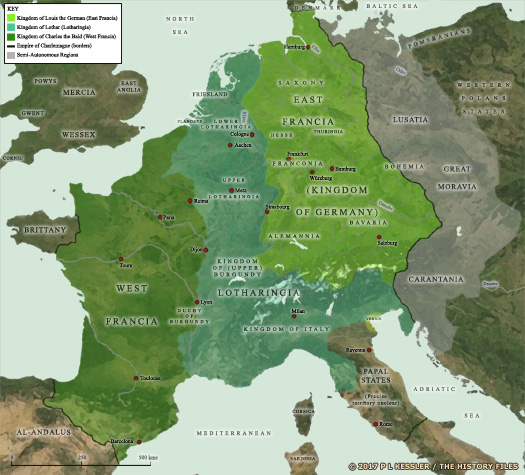 This map shows the division of the Carolingian empire between Charlemagne's three surviving grandsons according to the Treaty of Verdun in AD 843, but the 'march' that had penned in the Britons of Armorica was starting to fail (click or tap on map to view full sized) This map shows the division of the Carolingian empire between Charlemagne's three surviving grandsons according to the Treaty of Verdun in AD 843, but the 'march' that had penned in the Britons of Armorica was starting to fail (click or tap on map to view full sized) |
|
| The ambitious Nominoë, count of Vannes, does not settle for only one victory. Instead he boldly goes on to conquer Rennes and Nantes (with the help and support of Lambert of Nantes), as well as the provinces of Maine and Anjou. Breton territory has by now spread into Frankish lands where the Breton language is not spoken. It is from these victories that the history of the dukes of Brittany really begins. In order to gain even more freedom. Nominoë snatches Brittany from the authority of the archdiocese of Tours. Instead he founds the archdiocese of Dol in order to establish a self-governing Breton church which can continue to support the traditions of the Bretons. |
|
|
| 851 |
Nominoë's successors as duke of Brittany, from Erispoë to Alain Barbetorte, vigorously apply themselves to the protection of the duchy's independence from the [ Franks](../KingListsEurope/FranceFranks.htm#Western Franks) and Norsemen. Under the control of Duke Salaün (857-874), Brittany is even expanded as far as the Cotentin and Laval. It seems to be during this period that full Breton control over Vannes, Rennes, and Nantes is restored, consigning the former Frankish 'Breton March' to history. |
|
| 851 - 857 |
Erispoe / Erispoë (the Younger) |
Son. Duke of Brittany. Count of Vannes (& Poher?)? Murdered. |
| ? - 874? |
Ridoredh of Vannes |
Count of Vannes/Gwened (& Poher?). Prominent landowner. |
| 874 - 888 |
Ninth century Brittany is a very civilised place in which peasant property rights are enshrined in law and the powers of the prince (king or duke) are strictly limited. This is all undone when when Salaun is assassinated and the land overrun by Vikings. 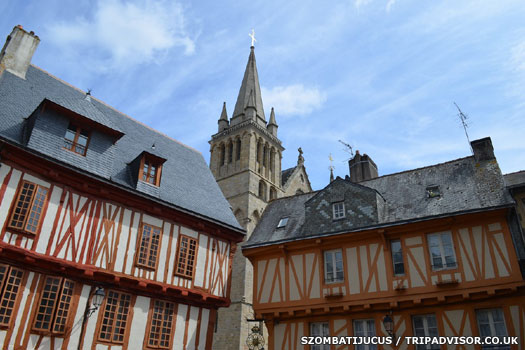 The medieval centre of Vannes was being laid down by this time, although it reached its current state during the sixteenth and seventeenth centuries, by which time Brittany was a French appendage The medieval centre of Vannes was being laid down by this time, although it reached its current state during the sixteenth and seventeenth centuries, by which time Brittany was a French appendage |
|
| Breton rule is eventually restored under Alain 'the Great', but in the meantime, Gurvand rules in Rennes and Pascweten in Vannes, and both are claimants to the throne. Pascweten is Salaun's son-in-law and also one of his assassins, along with Gurvand, and Wigo son of Rivelen of Cornouialle (and possibly also Poher). |
|
|
| Neither Gurvand or Pascweten are powerful enough to assume complete control so they fight it out amongst themselves for two years, and divide the country until both are dead. Pascweten's brother Alain continues the fight from Vannes against Judicaël of Rennes until the latter is killed when both team up to fight the Vikings. Alain now controls Brittany unopposed, although his numbering doesn't seem to account for two earlier Alains. |
|
|
| 874 - 877 |
Pascweten / Pasquitan |
Son. Brother of Alain I of Brittany. |
| 877 - 907 |
Alain I |
Brother. |
| ? - c.903 |
Pascweten / Pasquitan 'the Younger' |
Son. Possible count of Rennes. Predeceased his father. |
| 907 |
The death of Alain 'the Great', son of Ridoredh, results in instability in the land. Gourmaëlon, count of Kernev, seizes power and declares himself 'Prince of Brittany'. Ownership of Vannes is unclear at this time but Rudalt seems to be the count until he is forced to flee by the Vikings. Alain's son-in-law, Mathuedoï, would seem to succeed him as count of Poher at the same time. In Nantes the name of the current count seems to be unknown, although it is likely that he is a [ Frankish](../KingListsEurope/FranceFranks.htm#Western Franks) appointee.  The landscape of Armorica - extremely hilly inland with a wonderful, long coastline - would have seemed very familiar to the Britons who began to settle here from the late fourth century onwards (Glomel in the modern Côtes-d'Armor département is shown here) The landscape of Armorica - extremely hilly inland with a wonderful, long coastline - would have seemed very familiar to the Britons who began to settle here from the late fourth century onwards (Glomel in the modern Côtes-d'Armor département is shown here) |
|
| 907? - 919? |
Rudalt |
Brother. Fled the Vikings. |
| 913/914 |
The Loire Vikings invade, slaying King Gourmaëlon in battle and occupying Brittany. They establish their main naval base at the mouth of the Loire (at the southern edge of Brittany's lands), laying waste to Nantes, and then they use Brittany as a springboard for attacks on the [ Western Franks](../KingListsEurope/FranceFranks.htm#Western Franks) and the English (possibly in support of their kin in [East Anglia](EnglandEastAnglia.htm#Danish Kingdom)). It is possible that the Bretons also lose control of Vannes at this time. It is hard to say whether there is a sitting count of Vannes, although there do seem to be viable candidates for the position. Mathuedoï, count of Poher is married to the daughter of the late Alain 'the Great', and his son, Alan, is the godson of Edward 'the Elder', king of Wessex and all the English. Mathuedoï puts to sea with a great multitude of Bretons and travels to meet Edward: 'this king had great trust in him because of this friendship and the alliance of this baptism'. Brought up from infancy with Æthelstan (Edward's eldest son), 'Alan is strong in body and very courageous, and does not care to kill wild boars and bears in the forest with an iron weapon, but instead uses a wooden staff'. |
|
| 919? - 936? |
Mathuedoï / Malhuedoc I |
Brother-in-law. 'Count of Poher'. m daughter of Alain I. |
| 936 - 942 |
Having already encouraged a failed Breton rebellion against the Vikings, the monk Yann de Landévennec now calls on Alain to return to Brittany, which he does in 936 with the blessing and support of Æthelstan of [Wessex](EnglandWessex.htm#Kingdom United). Meanwhile, the future Hugh 'the Great' of Aquitaine is organising the return of Louis IV to [ West Francia](../KingListsEurope/FranceFranks.htm#Western Franks). Alain's campaign against the Loire Vikings is successful and he is declared Duke Alain II. 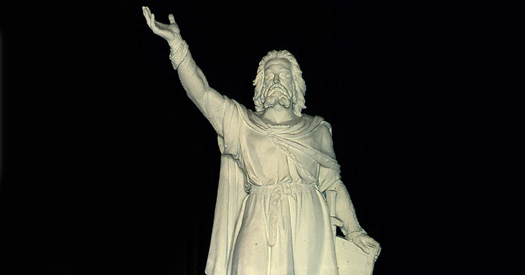 Mathuedoï's greatest claim to fame may be as the father of Alain II, duke of Brittany, Vannes, and Nantes, and count of Poher, who returned from exile to lead the Bretons to victory over the Loire Vikings and thereby recover the duchy Mathuedoï's greatest claim to fame may be as the father of Alain II, duke of Brittany, Vannes, and Nantes, and count of Poher, who returned from exile to lead the Bretons to victory over the Loire Vikings and thereby recover the duchy |
|
| Then he allies himself with his cousin, Judicael of Nantes (called 'Berenger' by the Franks) and Count Hugh II of Maine to attack the Seine Vikings (the Normans). The presence of a powerful cousin in Nantes who bears a distinctive Late Romano-British/Breton name would strongly signal that this town is still part of Brittany. |
|
|
| 936 - 952 |
Alain II 'the Fox' |
Son. Count of Poher. Duke of Vannes & Nantes, and Brittany. |
| 952 - 958 |
Drogo |
Son. Prince of Brittany. Last count of Vannes? |
| 958 - 990 |
Brittany appears to be ruled by the counts of Nantes at this time, probably Hoël or Guerech of Nantes. The numbering for Hoels as dukes would suggest that this particular Hoel is not involved (although this does not help in Guerech's case). After 990 the duchy is certainly ruled by the counts of Rennes upon the accession of Conan I, and until 1066. By this time, [ West Francia](../KingListsEurope/FranceFranks.htm#Western Franks) has finally suppressed a weakened Brittany, and the kings assume the title of 'Duke of Brittany' (and already appear to have done so earlier in this century). Even so, they maintain much of their independence until 1532. The county of Vannes seems to be terminated following the death of Drogo - or at least no longer has its own counts. Given that it still remains within Brittany the answer could be that it is drawn directly under the authority of the duke of Brittany himself, which position is now being fulfilled by the counts of Rennes. The important city of Nantes had until the reign of Alain II been joined to Vannes as a single county, but had been divided when Drogo had gained Vannes. 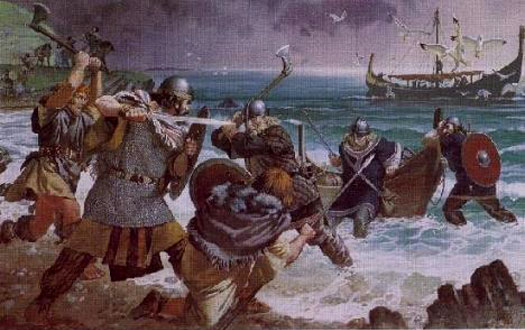 The tenth century Viking threat to Brittany had been a very serious one, with the notorious Loire Vikings effectively occupying the duchy between 914-936, before finally being ejected The tenth century Viking threat to Brittany had been a very serious one, with the notorious Loire Vikings effectively occupying the duchy between 914-936, before finally being ejected |
|
| An alternative possibility is that Vannes and Nantes are reunified following Drogo's death, now under the control of Nantes. Either way, events for Vannes largely follow the same path as those for Brittany as a whole. |
|
|
 |
|
|

 Vannetais was created during the late fourth century AD, enjoying a peak of expansion and power up until 491 (click or tap on map to view full sized)
Vannetais was created during the late fourth century AD, enjoying a peak of expansion and power up until 491 (click or tap on map to view full sized) This map shows the division of the Carolingian empire between Charlemagne's three surviving grandsons according to the Treaty of Verdun in AD 843, but the 'march' that had penned in the Britons of Armorica was starting to fail (click or tap on map to view full sized)
This map shows the division of the Carolingian empire between Charlemagne's three surviving grandsons according to the Treaty of Verdun in AD 843, but the 'march' that had penned in the Britons of Armorica was starting to fail (click or tap on map to view full sized) The medieval centre of Vannes was being laid down by this time, although it reached its current state during the sixteenth and seventeenth centuries, by which time Brittany was a French appendage
The medieval centre of Vannes was being laid down by this time, although it reached its current state during the sixteenth and seventeenth centuries, by which time Brittany was a French appendage The landscape of Armorica - extremely hilly inland with a wonderful, long coastline - would have seemed very familiar to the Britons who began to settle here from the late fourth century onwards (Glomel in the modern Côtes-d'Armor département is shown here)
The landscape of Armorica - extremely hilly inland with a wonderful, long coastline - would have seemed very familiar to the Britons who began to settle here from the late fourth century onwards (Glomel in the modern Côtes-d'Armor département is shown here) Mathuedoï's greatest claim to fame may be as the father of Alain II, duke of Brittany, Vannes, and Nantes, and count of Poher, who returned from exile to lead the Bretons to victory over the Loire Vikings and thereby recover the duchy
Mathuedoï's greatest claim to fame may be as the father of Alain II, duke of Brittany, Vannes, and Nantes, and count of Poher, who returned from exile to lead the Bretons to victory over the Loire Vikings and thereby recover the duchy The tenth century Viking threat to Brittany had been a very serious one, with the notorious Loire Vikings effectively occupying the duchy between 914-936, before finally being ejected
The tenth century Viking threat to Brittany had been a very serious one, with the notorious Loire Vikings effectively occupying the duchy between 914-936, before finally being ejected